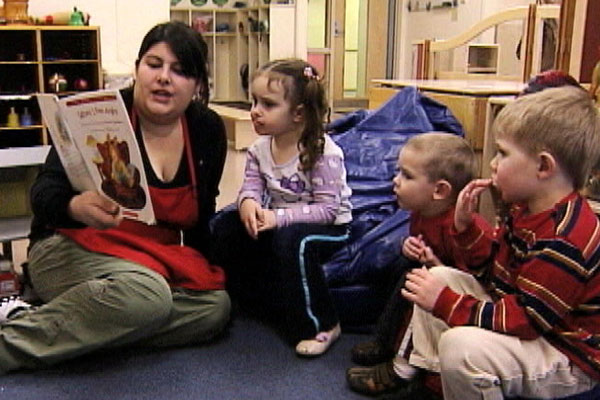Transcript for Using Literature to Help Children Manage Strong Emotions
Dr. Theresa Bouley, Professor of Early Literacy, Eastern Connecticut State University: Children’s literature is a powerful tool, because it allows children to talk about feelings and emotions when they’re not necessarily feeling them. When teachers can identify a children’s book that deals with a situation, or a sticky situation or a problem in the classroom, something that would typically happen that these children could have experience with, like sharing a toy or having to wait their turn, it’s not a charged issue for the children at that moment, so they can engage in conversation. It depersonalizes the issue; it doesn’t make it about them, about who’s having an issue, or whose turn it is, or who’s at fault, but it just is about the emotion or feeling.
Teacher: When I want to say something mean or yell or hit, there are other things that I can do.
Theresa Bouley: Another very important characteristic of children’s literature that’s most effective to use with children in talking about and labeling or understanding emotions are books that identify themes that children of that age group experience. A good example is a book called, “When Sophie Gets Angry, Really, Really Angry.” And when Sophie gets angry, she gets angry because she has to share a toy with her little sibling. To make matters worse, when her mother says she needs to share the toy, she turns around and trips on the truck that’s there. So we start out, before reading a story, and do this pre-reading. "What do you think the story is going to be about?" And, "Sophie gets angry, really, really angry. What do you think are some things that could make Sophie angry?" So this allows children to talk about what things happen in their lives that make them angry.
Child: Ballet makes me angry.
Teacher: Ballet makes you angry? Why does it make you angry?
Child: Cause.
Teacher: Because sometimes maybe you can’t do everything that the other kids can do?
Child: Yeah, I can’t rock, it’s too harder.
Teacher: Oh it’s too hard to walk? Is it on the balance beam?
Child: No, like this.
Teacher: Oh, to rock.
Theresa Bouley: And then post-reading, it becomes really important for children to have opportunities to talk about text, to talk about how they connected to the text, what their experiences are in relation to the characters’ experiences. It’s really important during that time to ask children a lot of open-ended questions about how they connected to the character or the theme or problem and the resolution to the problem in this particular story. We can ask them things like, "If they were the character what would you do differently?"
Teacher: What do you think would make you feel better when you’re angry?
Child: Well, well, if I was angry I would, I would just run, run, and run so much that would I get tired.
Teacher: You would run a lot so that you would get tired? That’s a good idea.
Theresa Bouley: During that time, we can do things like use chart paper to write down all the ways they would handle a similar situation, and we could post that around the room, and we could refer to that at later times when there are things that come up in the classroom.
May be reprinted for educational purposes.



